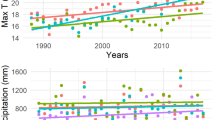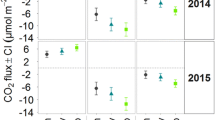Abstract
We investigated plant ecophysiological response to fertilization of selected sites along an elevation gradient in a pinyon-juniper woodland. Plant density and species composition followed typical patterns for pinyon-juniper woodlands over this gradient, with a sparse juniper (Juniperus monosperma (Engelm.) Sarg.)-grassland community at the lowest elevation and gradually increasing total canopy cover and pinyon (Pinus edulis Engelm.) cover with elevation. Carbon isotope analysis showed that both tree species had higher water-use efficiency (WUE) at the lowest, and presumably driest, sites. Over most of the gradient, however, it appeared that changes in stand density compensated for changes in water availability. Contrary to initial hypotheses, the more drought-tolerant juniper did not demonstrate significantly greater WUE than pinyon, although it maintained positive carbon gain at lower predawn xylem pressure potentials than pinyon. In pinyon, both A max and WUE increased with increasing N concentration in tissues. Pinyon needles also demonstrated declining nitrogen-use efficiency with age. There was no relationship between tissue N and either A max or WUE measured at A max in juniper, although δ13C analysis indicated that WUE increased in juniper with increased N availability. Results from this study suggest that plasticity in plant physiological processes could result in nonlinear responses of organic matter production to climate change, and therefore must be accounted for in ecosystem models.
Similar content being viewed by others
References
Barnes FJ (1986) Carbon gain and water relations in pinyon-juniper habit types. Dissertation, New Mexico State University, Las Cruces, NM
Charley JL (1972) The role of shrubs in nutrient cycling. In: McKell CM, Blaisdell JP, Goodwin JR (eds) Wildland shrubs — their biology and utilization. USDA Forest Service Gen Tech Rep INT-1, Washington, DC, pp 182–203
Comstock J, Ehleringer JR (1986) Canopy dynamics and carbon gain in response to soil water availability in Encelia frutescens Gray, a drought-deciduous shrub. Oecologia 68: 271–278
DeLucia EH, Schlesinger WH, Billings WD (1988) Water relations and the maintenance of Sierran conifers on hydrothermally altered rock. Ecology 69: 303–311
DeLucia EH, Schlesinger WH (1991) Resource-use efficiency and drought tolerance in adjacent Great Basin and Sierran plants. Ecology 72: 51–58
Ehleringer JR, Cooper TA (1988) Correlations between carbon isotope ratio and microhabitat in desert plants. Oecologia 76: 562–566
Ehleringer JR (1989) Carbon isotope ratios and physiological processes in aridland plants. In: Rundel PW, Ehleringer JR, Nagy KA (eds) Stable isotopes in ecological research. Springer-Verlag, Berlin, pp 41–54
Farquhar GD, O'Leary MH, Berry JA (1982) On the relationship between carbon isotope discrimination and the intercellular carbon dioxide concentration in leaves. Aust J Plant Physiol 19: 121–137
Farquhar GD, Hubick KT, Condon AG, Richards RA (1989) Carbon isotope fractionation and plant water-use efficiency. In: Rundel PW, Ehleringer JR, Nagy KA (eds) Stable isotopes in ecological research. Springer-Verlag, Berlin, pp 21–40
Field C, Mooney HA (1983) Leaf age and seasonal effects on light, water, and nitrogen use efficiency in a California shrub. Oecologia 56: 348–355
Field C, Mooney HA (1986) The photosynthesis-nitrogen relationship in wild plants. In: Givnish TJ (ed) On the economy of plant form and function. Cambridge University Press, Cambridge, pp 25–55
Field C, Merino J, Mooney HA (1983) compromises between water-use efficiency and nitrogen-use efficiency in five species of California evergreens. Oecologia 60: 384–389
Fisher FM, Zak JC, Cunningham GL, Whitford WG (1988) Water and nitrogen effects on growth and allocation patterns of creosotebush in the northern Chihuahuan Desert. J Range Manage 41: 387–391
Friend AD, Woodward FI, Switsur VR (1989) Field measurements of photosynthesis, stomatal conductance leaf nitrogen and δ13C along altitudinal gradients in Scotland. Funct Ecol 3: 117–122
Grier CC, Running SW (1977) Leaf area of mature coniferous forests: relation to site water balance Ecology 58: 893–899
Körner Ch, Diemer M (1987) In situ photosynthetic responses to light, temperature and carbon dioxide in herbaceous plants from low and high altitude. Funct Ecol 1: 179–194
Körner Ch, Farquhar GD, Roksandic Z (1988) A global survey of carbon isotope discrimination in plants from high altitude. Oecologia 74: 623–632
Körner Ch, Farquhar GD, Wong SC (1991) Carbon isotope discrimination by plants follows latitudinal and altitudinal trends. Oecologia 88: 30–40
Lajtha K, Barnes FJ (1991) Carbon gain and water use in pinyon pine-juniper woodlands of northern New Mexico: field versus phytotron chamber measurements. Tree Physiol 9: 59–67
Lajtha K, Marshall JD (1993) Natural abundance stable isotopes in plant ecophysiological research. In: Lajtha K, Michener RM (eds) Stable isotopes in ecology. Blackwell Scientific, Oxford (in press)
Lajtha K, Whitford WG (1989) The effect of water and nitrogen amendments on photosynthesis, leaf demography, and resource-use efficiency in Larrea tridentata, a desert evergreen shrub. Oecologia 80: 341–348
Lane LJ, Barnes FJ (1987) Water balance calculations in south-western woodlands. In: Everett RL (ed) Proceedings — pinyon-juniper conference. Intermontain Research Station, Ogden, Utah, pp 480–488
Lauenroth WK, Dodd JL, Sims PL (1978) The effects of water- and nitrogen-induced stresses on plant community structure in a semiarid grassland. Oecologia 36: 211–222
Linder S, Axelsson B (1982) Changes in carbon uptake and allocation patterns as a result of irrigation and fertilization in a young Pinus sylvestris stand. In: Waring RH (ed) Carbon uptake and allocation: key to management of subalpine forest ecosystems. Forest Research Lab, Oregon State University, Corvallis, pp 38–44
Linder S, Rook DA (1984) Effects of mineral nutrition on carbon dioxide exchange and partitioning of carbon in trees. In: Bowen GD, Nambiar EKS (eds) Nutrition of plantation forests. Academic Press, Orlando, pp 211–236
Lowther JR (1980) Use of a single sulfuric acid-hydrogen peroxide digest for the analysis of Pinus radiata needles. Commun Soil Sci Plant Anal 11: 175–188
Ludwig JA, Flavill P (1979) Productivity patterns of Larrea in the northern Chihuahuan Desert. In: Lopez EC, Mabry TJ, Tavizopp SF (eds) Larrea Derie el Desierto, vol. 2. Centro de Invest. en Quim. Apl., Saltillo, Coahuila, Mexico, pp 139–150
Mooney HA, Bullock SH, Ehleringer JR (1989) Carbon isotope ratios of plants of a tropical dry forest in Mexico. Functional Ecology 3: 137–142
Morecroft MD, Woodward FI (1990) Experimental investigations on the environmental determination of δ13C at different altitudes. J Exp Bot 41: 1303–1308
Nemani RR, Running SW (1989) Testing a theoretical climate-soil-leaf area hydrologic equilibrium of forests using satellite data and ecosystem simulation. Agric Forest Met 44: 245–260
Padien DJ, Lajtha K (1992) Plant spatial pattern and nutrient distribution in pinyon-juniper woodlands along an elevational gradient in northern New Mexico. Int J Plant Sci 153: 425–433
Pastor J, Post WM (1986) Influence of climate, soil moisture, and succession on forest carbon and nitrogen cycles. Biogeochemistry 2: 3–27
Pieper RD, Lymbery GA (1987) Influence of topographic features on pinyon-juniper vegetation in south-central New Mexico. In: Everett RL (ed) Proceddings — pinyon-juniper conference. Intermontain Research Station, Ogden, Utah, pp 53–57
Reader RJ (1978) Contribution of overwintering leaves to the growth of three broad-leaved, evergreen shrubs belonging to the Ericaceae family. Can J Bot 56: 1248–1261
Reynolds JF, Cunningham GL (1981) Validation of a primary production model of the desert shrub Larrea tridentata using soil-moisture agumentation experiments. Oecologia 51: 357–363
SAS Institute Ins (1982) SAS User's Guide: Statistics, 1982 edition. SAS Institute Inc., Cary, NC
Shaver GR (1983) Mineral nutrition and leaf longevity in Ledum palustre: the role of individual nutrients and the timing of leaf mortality. Oecologia 56: 160–165
Smedley MP, Dawson TE, Comstock JP, Donovan LA, Sherrill DE, Cook CS, Ehleringer JR (1991) Seasonal carbon isotope discrimination in a grassland community. Oecologia 85: 314–320
Tilman D (1987) Secondary succession and the pattern of plant dominance along experimental nitrogen gradients. Ecological Monographs 57: 189–214
Toft NL, Anderson JE, Nowack RS (1989) Water use efficiency and carbon isotope composition of plants in a cold desert environment. Oecologia 80: 11–18
Turner J, Olsen PR (1976) Nitrogen relations in a Douglas-fir plantation. Ann Bot 40: 1185–1193
Vitousek PM, Field CB, Matson PA (1990) Variation in foliar δ13C in Hawaiian Metrosideros polymorpha: a case of internal resistance? Oecologia 84: 362–370
West NE, Rea KH, Tausch RJ (1975) Basic synecological relationships in pinyon-juniper woodlands. In: Gifford G, Busby FE (eds) The pinyon-juniper ecosystem: symposium. Utah State University, Logan, Utah, pp 41–52
Woodbury AM (1974) Distribution of pigmy conifers in Utah and northeastern Arizona. Ecology 28: 115–126
Woodin HE, Lindsey AA (1954) Juniper-pinyon east of the Continental Divide, as analyzed by the line-strip method. Ecology 35: 473–489
Author information
Authors and Affiliations
Rights and permissions
About this article
Cite this article
Lajtha, K., Getz, J. Photosynthesis and water-use efficiency in pinyon-juniper communities along an elevation gradient in northern New Mexico. Oecologia 94, 95–101 (1993). https://doi.org/10.1007/BF00317308
Received:
Accepted:
Issue Date:
DOI: https://doi.org/10.1007/BF00317308




